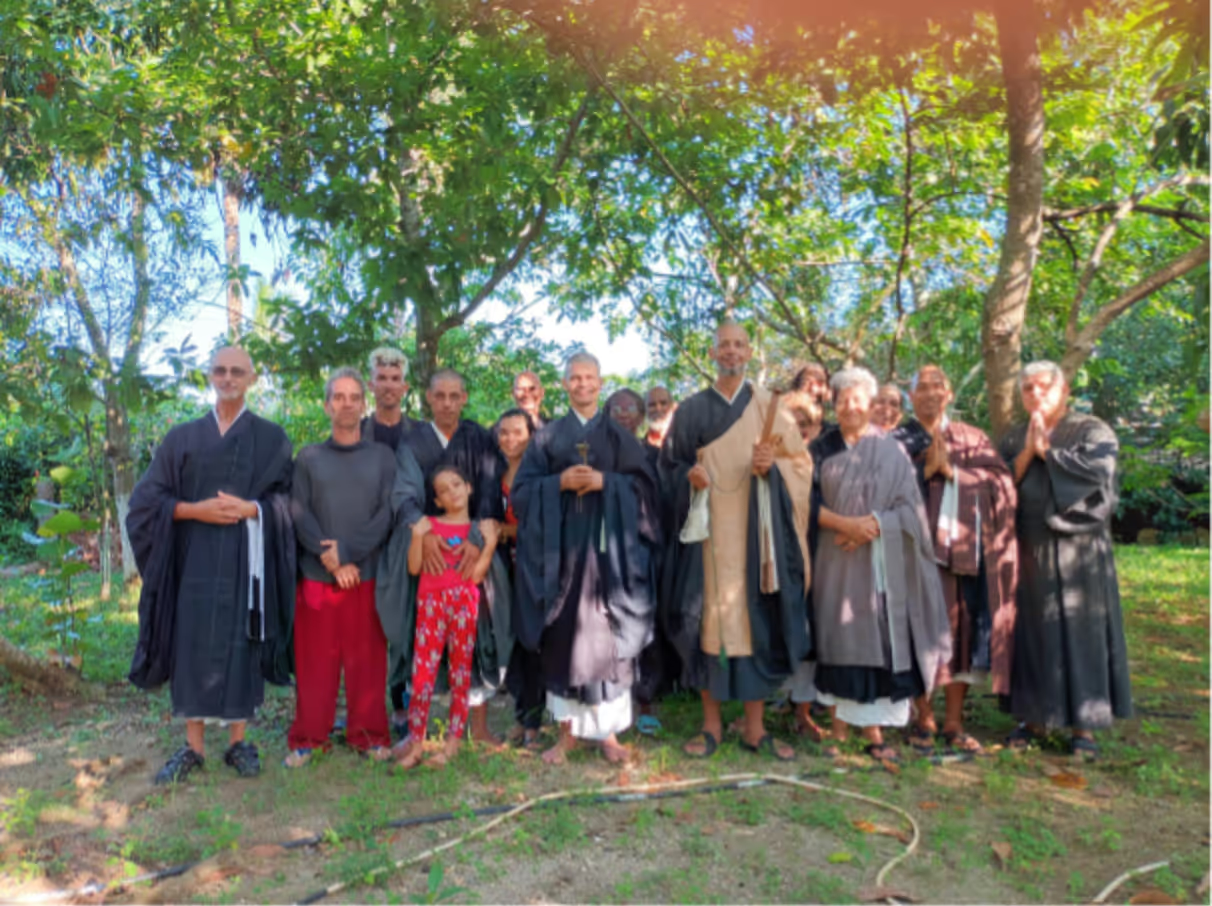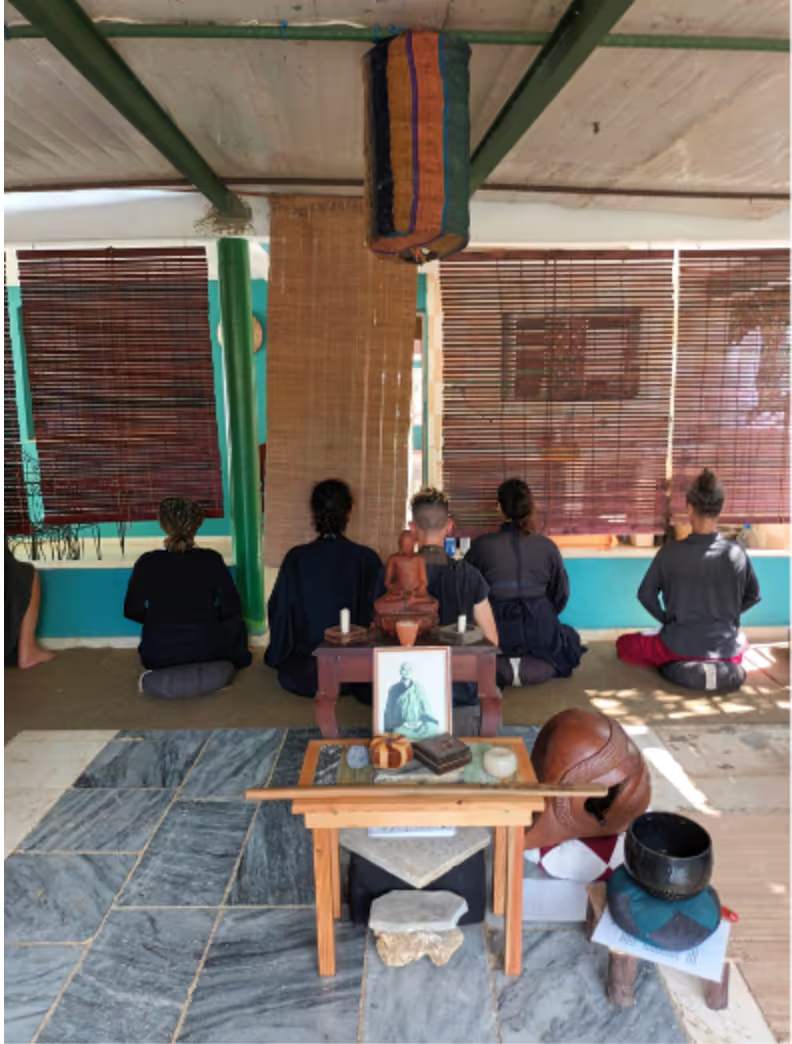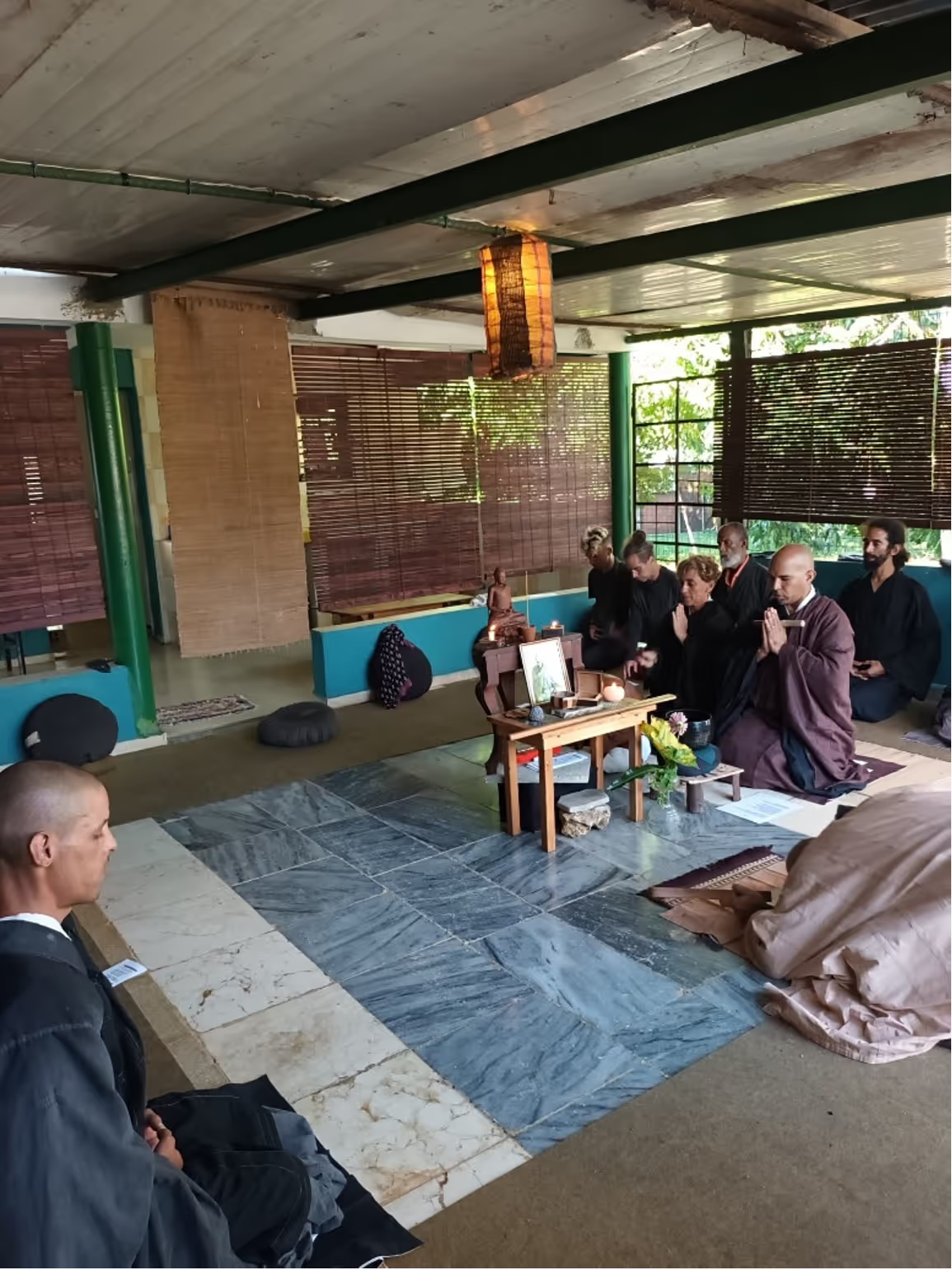
We left Madrid with suitcases crammed with food that we had collected to take to our classmates from the Cuban sangha. It had not been a year since the project for a Zen temple in Cuba had been completed. In October 2022, we had signed the purchase deeds and now we arrived with kilos of food and objects that could not be found on the Caribbean island. The news in the spring of 2023 was that people were hungry and there were queues of up to three days to get some gas.
We were in the middle of June, summer was beginning and our flight was full of Cubans who brought to their families all kinds of products from the free world or rather from the consumer orgy of that free world.
At Barajas airport there were huge queues. Cubans make bundles with the clothes and utensils they bring to their compatriots, wrap them in kitchen plastic and then in plastic packaging so they can carry more things without weighing their suitcase. Each traveler could bring two packages, each weighing twenty-five kilos plus another of ten kilos in the cabin, in addition to the hand bag.
Upon arriving at the Havana airport, Maestro Michel Tei Hei, a tall and slender Cuban with a wide smile, was waiting for us. In the midst of the airport fuss, he was confused between travelers and residents, and he soon found us. I had obtained a “haiga” type vehicle from the fifties, the old American junk abandoned by its owners, who call them there Almendrones. He picked us up with an extensive almond tree repainted in operating room green, and we placed the large suitcases in the cabin and trunk.

On the road, traveling to the new temple, we overtook several wagons drawn by jumping horses, an alternative to the shortage of oil. Some people walked along the edges of a bumpy road or waited patiently at filthy stops. It was like returning to the past, to the time of my childhood in Spain in the seventies when animal traction and people walking on roads and roads were still left in the villages and the countryside.
The temple of Kosen Shin-ji is located twenty kilometers from Havana, in a rural area that reminded me of Tamaulipas, in the Mexican tropic of cancer, where I lived for a few years. Everything was green, with lush vegetation and huge trees full of mangoes, soursops, avocados, dwarves, plums; there were also coconut, pomegranate, custard apple, banana, orange and lime trees. Tall and green trees, round and squat, in palm trees or shrubs, all vegetation that gave freshness to the high temperatures of the day.

The name of the Kosen-shin-ji temple is a tribute to the Kosen sangha, to the teachers Stefan and Barbara, and in Japanese it means “the hermit's wisdom”.
The temple is in the area known as “La Lettuce” with numerous houses around the street and the road, small farms with vegetable gardens, chickens, cows and pigs. When you walk around this colony the little dogs are free, they are not tied up or walk on a leash or in ridiculous little clothes. They lie down on the road or on the road quietly, watching you, wagging their tails and scaring away flies. The children play on the road and smile, not with their attention on a mobile phone or tablet, but on the little dog, the puppy that is called “Cloud”. Everything is like a leap in the void, time stopped. A time full of life.
The property that Michel Tei Hei's Zen sangha acquired belonged to a bricklayer who immigrated to the United States trying to improve his life and his possibilities. A few months after selling it, the man returned to buy it back; he regretted having sold it, it was his “paradise” and he had come to a life that was his “hell”.

Many are leaving, especially young people, contemplating a future with more possibilities in other countries; in the “free” world of consumption. Michel complains that some people who commit and order end up leaving for Europe or Canada, the United States and Mexico, looking for more possibilities, a future.
For those who remain, the dojo, the practice of zazen and the Way are a refuge, a support in difficult times; a community of mutual help where interdependence becomes more valuable for survival on a daily basis. At least in the sesshines they will eat well, says Michel as he opens the suitcases and discovers their contents.
The plot is an orchard, in addition to the original trees, they have planted an orchard with carrots, pumpkins, onions, chilies, sweet potatoes... they are practically self-sufficient. We have brought them many packages of seeds and foods that do not spoil and that have a lot of vegetable protein such as beans, lentils, chickpeas and soybeans, as well as olive oil and tomato concentrate.

Little by little, other members of the sangha are arriving. The trip is long and complicated, even if they are only 20 km from Havana. The monk Gustavo has hired a minibus, and they all arrive in droves, both older and younger, as the two girls of Andrés, who is a monk, and his wife also come. They are young women and men, the oldest will be about 40 years old. Everyone with a big smile to meet the members of the Spanish sangha, although Gustavo is an old acquaintance and the promoter of this new temple in Cuba. Those who come from Matanzas (only 120 km away) or from other parts of the island will not arrive until the next day, after a 15-hour trip combining several buses and dead hours.
The neighbors take care of some cows, they are the cows of the Revolution, well, of the government. Yoni knows everything about cows, but they only eat grass and don't support them with feed because it's now very expensive (she comes from Ukraine). The cows are refractory, dying of hunger, and almost all of them are anaemic. Also in Cuba, as in other parts of the world, they are suffering prolonged periods of drought, and although it now rains in the evenings, there have been months without a single drop of rain.

In the countryside you don't go hungry; there are people nearby with chickens and pigs, although everything is very controlled by the community, because everywhere there are “political commissars” who report on the animals they raise and all the activities that take place in the countryside (and in the city). Cubans have no custom or tradition of gardening, as their island was so fertile, few cultivate an orchard, we are the exception. The garden is life, they are insects, and birds, and flowers, and lots of fruit at any time, delicious mangoes in the middle of summer, juicy and sweet, and guavas or plums. To eat the fruit of the trees is to reconnect with everything, with nature and with the primitive being that we still carry inside us; a great pleasure and a privilege.
The dream is deep. In each room there is a powerful fan that cools you down at night. The rooms are austere, but we sleep in beds, with clean sheets, or on mats; and we have a full bathroom to clean ourselves, with running water, showers and toilets. Of course, here, as in almost every house, you wash yourself using a Cuban shower: in pots of water (warm or hot) from the bucket that we have filled. It is a simple way of life, without excesses, returning to the elementary, without desires beyond what is strictly necessary, a good practice for Europeans and North Americans who come from countries of affluence.
In the morning during Zazen you can hear the roosters kikiriki. Nature is fully present. At dawn, while we are sitting in Zazen, we can hear the sounds of this community: roosters and all kinds of birds and the croaking of frogs. When you stay silent in Zazen, all these sounds come up, the conversations that people have on the street, which fade away as they walk away.

Today we had a new practitioner: the frog that jumped from a water pipe, joined the dojo and then the altar. He spent more than two hours under the statue of the Buddha, so quiet; then he posed next to the photo of Master Deshimaru, and he stayed there until the end.
The sangha was founded in 1997 on a journey by master Stefan Kosen. He came several times a year. And in 2005, teacher Barbara Kosen took over the responsibility at Stefan's request. Since then she has attended the sangha, although other teachers have also come: Pierre, Ingrid, Vincent. Michel Tei Hei has experienced the liturgy of all of them, without rigidities, without orthodoxies, each with different forms, but always in the spirit of the Way.

At the beginning of the 21st century, they tried to give legal form to the sangha, creating an association. They went to enroll her in the appropriate body and they kept trying, they wouldn't let them. There is a lot of suspicion of any type of religious or cultural organization, because they think that they may be enemies of the revolution or envoys of imperialism and so on, and so on, a continuous paranoia.

I have run out of a mobile phone, in other words, my charger broke and I have to keep what little battery I have left to try to fix it when I arrive in Spain; then, I don't use it at all. I am completely disconnected, something completely necessary. I realize that this sesshin and this trip to Cuba allows me to make a digital cure, a detachment from computers, mobile phones, websites and search engines, applications and all the digital paraphernalia in which we have been immersed for more than twenty years. Also from television, radio, soap operas and politics. Something very hygienic, very healthy for anyone. Without technology I am very happy, I have recovered my pen and paper and my ideas slip between lines, naturally and easily. I sew, listen, read and write. Although technology is essential, it is very healthy to do this type of digital cleansing cure, which, combined with a simple life without desires or purchases, makes me feel that I am doing a complete cure, for body and soul.
Just before the start of the sesshin, during the previous days of preparation, Master Michel had to make a series of steps; he went to the bank and since the ATM was open and operational, there was a three-hour queue. For some years now, Cubans have had to have a kind of bank account in MLC (freely convertible currency), a card to manage money and be able to purchase goods or food outside the ration card, which provides less and less food. A three-hour queue is life, it's life standing in line, all are queues.
When Fidel came to power, he dismantled all the sugar mills. The profession that had passed from parents to children, training, was lost. Since they were the world's first sugar producers, after their retirement, the price of sugar rose again, because beet sugar is infinitely worse. Fidel let this industry die, claiming that there were no spare parts. Once the world's leading producer withdrew, the price of sugar rose again, but they were already out of the market. The same thing has happened with agricultural products; children no longer know what an orange is, they say that the ones they grow are exported; there are no oranges to consume. In 1995, when I first traveled to Cuba, there were oranges everywhere. Almost thirty years have passed and they are nowhere to be seen.

At the end of the sesshin we enjoyed a few days in Havana. I visited several impeccable evangelist temples and the Christopher Columbus Cemetery church in Vedado. I got into the twists and turns of streets and stalls. Old Havana is splendid, it's a very beautiful city. Declared a World Heritage Site by UNESCO in 1982, it has been restored little by little. But in these hot months there is hardly any tourism and the merchants of the San José flea market try by all means to get the few tourists to buy in their stores.
We stayed in Vedado, an upper-middle class residential neighborhood, at its peak at the end of the 19th century and after Independence, and where single-family houses that were authentic mansions, and that today yawn in the face of the laziness and lack of means of their current owners. Some houses are recovering. Cuba lives on the foreign exchange that emigrants send, and some, in a very good situation, have been able to purchase houses in good condition for their resident families.

Our dojo is also in Vedado, in an amazing art deco building. On the third floor and distributed in various directions, the breeze circulates and caresses your back while you are seated in Zazen. Our Cuban colleagues from Sesshin have been arriving little by little, some of them moving from very distant neighborhoods and making the effort to arrive after several hours of walking or waiting for public transport. Quite a daily feat.

For us Europeans, the practice of zazen in Cuba is an example of dignity and decision. Even with all the difficulties, people practice the Way and everything that entails. Michel Tei Hei's sangha organizes a sesshin every month in the new temple, allowing extended stays for foreign visitors, and during the Christmas holidays they organize a more extensive sesshin. This is when spring temperatures attract many visitors from other latitudes. For us, those of us who live in the “free” world of consumption, visiting Cuba and practicing zazen with the Cuban sangha has been a prize and a unique experience that I recommend to everyone.
Teacher Michel's phone number and WhatsApp in Cuba is +5353496254 and the email address of the Cuban dojo: zazencuba@gmail.com.They are listed on Instagram as templo_zen_kosenshinji.










